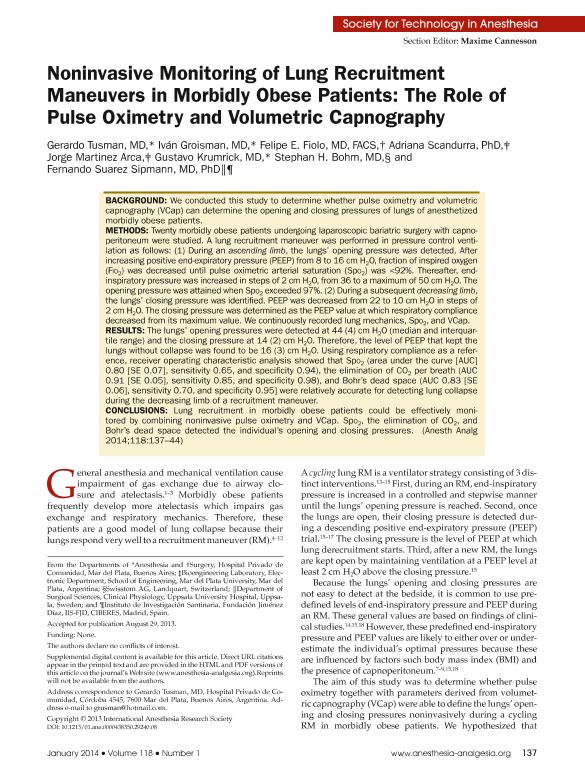Artículo
Noninvasive monitoring of lung recruitment maneuvers in morbidly obese patients: the role of pulse oximetry and volumetric capnography
Tusman, Gerardo; Groisman, Iván; Fiolo, Felipe E.; Scandurra, Adriana; Martinez Arca, Jorge ; Krumrick, Gustavo; Bohm, Stephan H; Suarez-sipmann, Fernando
; Krumrick, Gustavo; Bohm, Stephan H; Suarez-sipmann, Fernando
 ; Krumrick, Gustavo; Bohm, Stephan H; Suarez-sipmann, Fernando
; Krumrick, Gustavo; Bohm, Stephan H; Suarez-sipmann, Fernando
Fecha de publicación:
29/08/2013
Editorial:
Lippincott, Williams
Revista:
Anesthesia And Analgesia
ISSN:
0003-2999
Idioma:
Inglés
Tipo de recurso:
Artículo publicado
Clasificación temática:
Resumen
BACKGROUND: We conducted this study to determine whether pulse oximetry and volumetric capnography (VCap) can determine the opening and closing pressures of lungs of anesthetized morbidly obese patients.
METHODS: Twenty morbidly obese patients undergoing laparoscopic bariatric surgery with capnoperitoneum were studied. A lung recruitment maneuver was performed in pressure control ventilation as follows: (1) During an ascending limb, the lungs? opening pressure was detected. After increasing positive end-expiratory pressure (PEEP) from 8 to 16 cm H2O, fraction of inspired oxygen (FIO2) was decreased until pulse oximetric arterial saturation (SpO2) was <92%. Thereafter, end-inspiratory pressure was increased in steps of 2 cm H2O, from 36 to a maximum of 50 cm H2O. The opening pressure was attained when SpO2 exceeded 97%. (2) During a subsequent decreasing limb, the lungs? closing pressure was identified. PEEP was decreased from 22 to 10 cm H2O in steps of 2 cm H2O. The closing pressure was determined as the PEEP value at which respiratory compliance decreased from its maximum value. We continuously recorded lung mechanics, SpO2, and VCap.
RESULTS: The lungs' opening pressures were detected at 44 (4) cm H2O (median and interquartile range) and the closing pressure at 14 (2) cm H2O. Therefore, the level of PEEP that kept the lungs without collapse was found to be 16 (3) cm H2O. Using respiratory compliance as a reference, receiver operating characteristic analysis showed that SpO2 (area under the curve [AUC] 0.80 [SE 0.07], sensitivity 0.65, and specificity 0.94), the elimination of CO2 per breath (AUC 0.91 [SE 0.05], sensitivity 0.85, and specificity 0.98), and Bohr's dead space (AUC 0.83 [SE 0.06], sensitivity 0.70, and specificity 0.95] were relatively accurate for detecting lung collapse during the decreasing limb of a recruitment maneuver.
CONCLUSIONS: Lung recruitment in morbidly obese patients could be effectively monitored by combining noninvasive pulse oximetry and VCap. SpO2, the elimination of CO2, and Bohr's dead space detected the individual's opening and closing pressures.
Archivos asociados
Licencia
Identificadores
Colecciones
Articulos(CCT - MAR DEL PLATA)
Articulos de CTRO.CIENTIFICO TECNOL.CONICET - MAR DEL PLATA
Articulos de CTRO.CIENTIFICO TECNOL.CONICET - MAR DEL PLATA
Articulos(INTEMA)
Articulos de INST.DE INV.EN CIENCIA Y TECNOL.MATERIALES (I)
Articulos de INST.DE INV.EN CIENCIA Y TECNOL.MATERIALES (I)
Citación
Tusman, Gerardo; Groisman, Iván; Fiolo, Felipe E.; Scandurra, Adriana; Martinez Arca, Jorge; et al.; Noninvasive monitoring of lung recruitment maneuvers in morbidly obese patients: the role of pulse oximetry and volumetric capnography; Lippincott, Williams; Anesthesia And Analgesia; 118; 1; 29-8-2013; 137-144
Compartir
Altmétricas



